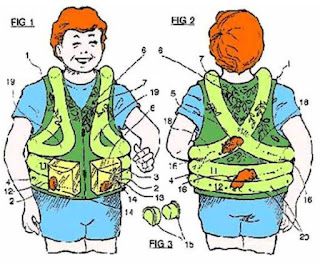The other day, a young lady came into my law library. Seems she had invented a device that help people breath filtered air. It was her hope and dream that her invention would be patented and make her lots of money. The problem was that her patent claim was rejected and young lady was in our library to find out why.
Now, in case you were wondering about the the picture associated with this blog, this is a Hamster shirt. What is a hamster shirt? What it looks like is a hamster cage that wraps around a person. Weird, but what do I know? What I do know is that it is one of millions of patent applications that have been rejected over the years.
Why, you might ask, would a patent application be rejected? Good question. There are a number of reasons a patent might be rejected, such as:
Who knows - maybe young lady really is on to something. Maybe her design is novel enough to squeak by. Maybe Santa will smile kindly on young lady and give her some pointers. Who knows?
What I do know is that if you have a idea that you've been working on and you're sure will sell like hotcakes, waste not a moment and head on over to your local county law library and read up on how to not get your design rejected.
Now, in case you were wondering about the the picture associated with this blog, this is a Hamster shirt. What is a hamster shirt? What it looks like is a hamster cage that wraps around a person. Weird, but what do I know? What I do know is that it is one of millions of patent applications that have been rejected over the years.
Why, you might ask, would a patent application be rejected? Good question. There are a number of reasons a patent might be rejected, such as:
- Invention is Obvious. Basically, this means that the invention’s claimed elements can be found in a number of prior works.
- Lack of Novelty. This means that an invention is too closely related to a single work which has been done before. Novelty is different than non-obviousness. While an "obvious" rejection can be based on several references, a novelty rejection needs only one reference.
- Claims Written Incorrectly. Writing a patent claim is difficult. In fact, failure to correctly write a claim and is an easy reason for claim rejection. For example:
- If the claims are not punctuated correctly it can be rejected.
- If the elements for a claim are not properly introduced, it can be rejected.
- If the claims are directed to elements not identified in the drawings, it can be rejected.
- If the claim uses terms inconsistently, it can be rejected.
- If the claim refers to features or arrangements in the alternative, it can be rejected.
- If the claim is not written in proper dependent form, it can be rejected.
- Issues with the Drawings. While requirements for the actual drawing of picture have been relaxed over time, there are still a number of ways the drawings can create problems. For example,
- The of shading, greys, or colors will often lead to a rejection.
- Stray marks, blurry lines, and smudges will cause problems.
- If a drawing is indicated as having only pure black-and-white marks, but actually contains some grey (even grey that looks entirely black), this can lead to a rejection.
- Issues with the Written Description. The written description provides support for a claim. A lack of a supportable written description can manifest itself in a number of ways.
- The written description may not disclose the best mode or expression of how an invention is used.
- The written description may not adequately describe how the invention is made (so that someone with skill similar to the inventor could replicate the invention).
- The written description states that the inventor invented the intention and that he is in possession of the invention.
- Invention is for Non-Patentable Subject Matter. Most things are patentable, but some aren’t. For example, you can't patent
- the law of gravity, or
- a mathematical formula, or
- a method of organizing human behavior, or
- naturally occurring elements (like water or air).
- Patent, Copyright & Trademark: an intellectual property desk reference (Nolo Press)
- How to Make Patent Drawings (Nolo Press)
- Moy's Walker on Patents (TR)
- Manual of Patent Examination Procedures (TR)
Who knows - maybe young lady really is on to something. Maybe her design is novel enough to squeak by. Maybe Santa will smile kindly on young lady and give her some pointers. Who knows?
What I do know is that if you have a idea that you've been working on and you're sure will sell like hotcakes, waste not a moment and head on over to your local county law library and read up on how to not get your design rejected.

No comments:
Post a Comment